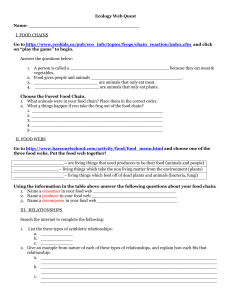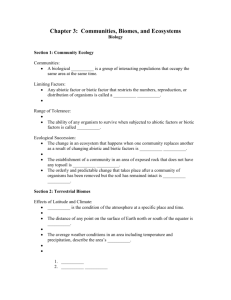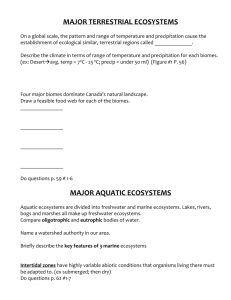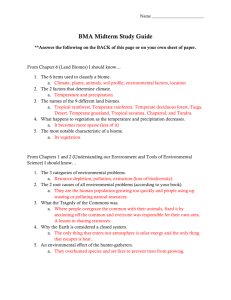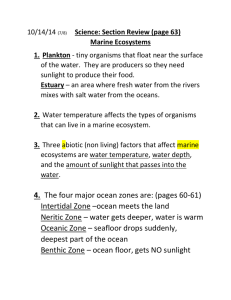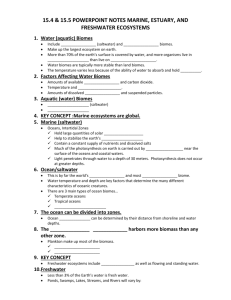Science Chapter 4 Study Guide The Earth`s Ecosystems SECTION 1
advertisement
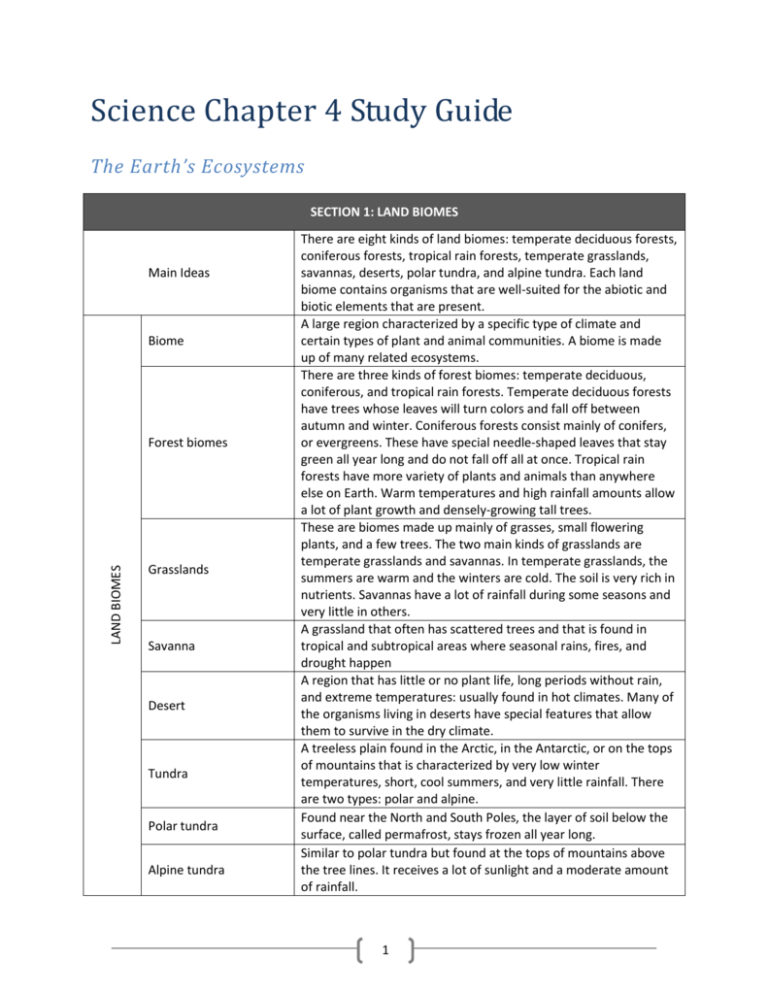
Science Chapter 4 Study Guide The Earth’s Ecosystems SECTION 1: LAND BIOMES Main Ideas Biome LAND BIOMES Forest biomes Grasslands Savanna Desert Tundra Polar tundra Alpine tundra There are eight kinds of land biomes: temperate deciduous forests, coniferous forests, tropical rain forests, temperate grasslands, savannas, deserts, polar tundra, and alpine tundra. Each land biome contains organisms that are well-suited for the abiotic and biotic elements that are present. A large region characterized by a specific type of climate and certain types of plant and animal communities. A biome is made up of many related ecosystems. There are three kinds of forest biomes: temperate deciduous, coniferous, and tropical rain forests. Temperate deciduous forests have trees whose leaves will turn colors and fall off between autumn and winter. Coniferous forests consist mainly of conifers, or evergreens. These have special needle-shaped leaves that stay green all year long and do not fall off all at once. Tropical rain forests have more variety of plants and animals than anywhere else on Earth. Warm temperatures and high rainfall amounts allow a lot of plant growth and densely-growing tall trees. These are biomes made up mainly of grasses, small flowering plants, and a few trees. The two main kinds of grasslands are temperate grasslands and savannas. In temperate grasslands, the summers are warm and the winters are cold. The soil is very rich in nutrients. Savannas have a lot of rainfall during some seasons and very little in others. A grassland that often has scattered trees and that is found in tropical and subtropical areas where seasonal rains, fires, and drought happen A region that has little or no plant life, long periods without rain, and extreme temperatures: usually found in hot climates. Many of the organisms living in deserts have special features that allow them to survive in the dry climate. A treeless plain found in the Arctic, in the Antarctic, or on the tops of mountains that is characterized by very low winter temperatures, short, cool summers, and very little rainfall. There are two types: polar and alpine. Found near the North and South Poles, the layer of soil below the surface, called permafrost, stays frozen all year long. Similar to polar tundra but found at the tops of mountains above the tree lines. It receives a lot of sunlight and a moderate amount of rainfall. 1 SECTION 2: MARINE ECOSYSTEMS MARINE ECOSYSTEM Main ideas Marine ecosystem Plankton Phytoplankton MAJOR OCEAN ZONES Major zones in the ocean Intertidal zone Neritic zone Oceanic zone TYPES OF MARINE ECOSYSTEMS Benthic zone Estuary Coral reef The abiotic factors that affect marine ecosystems are temperature, water depth, and sunlight. The major zones found in the ocean are the intertidal zone, the neritic zone, the oceanic zone, and the benthic zone. Many different kinds of organisms live in marine ecosystems, from producers like phytoplankton to consumers like whales. The ecosystems that are found in the oceans of the Earth. They are affected by abiotic factors: temperature, water depth, and sunlight. The surface of the oceans is much warmer than the deeper parts, and tropical seas are much warmer, too, than the polar seas. These temperatures affect the animals that live in the oceans. Water depth affects the oceans in that producers need sunlight in order to produce food. The average depth of the oceans is 4,000 meters, but sunlight does not reach deeper than 200 meters. Tiny organisms that float near the surface of the ocean. Many are producers, using photosynthesis to make their own food. They are the base of most ocean food chains. Large consumers, such as whales, feed on plankton. Plankton that use photosynthesis to make their own food The major zones in the ocean are based on things such as water depth, sunlight, and water temperature. Those zones are the intertidal zone, the neritic zone, the oceanic zone, and the benthic zone. The place where the ocean meets the land. Organisms of the intertidal zone are covered with water at high tide and exposed to air at low tide. An intertidal area can include mudflats, sandy beaches, and rocky shores. This area has warm, sunlight water and is where the ocean floor begins to slope downward. This zone contains the deep water of the ocean and is where the sea floor drops off quickly. Phytoplankton live near the surface, where there is sunlight. This is the ocean floor. It receives no sunlight and is very cold. An area where fresh water flows into the ocean. Organisms living here must be able to survive the changing amounts of salt in the water. These areas are named for the small animals called corals that form the reefs. Corals live together in a colony. When they die, their hard skeletons remain, forming a rock-like structure called a reef. The reefs then become home to many marine animals. Coral reefs are some of the most diverse ecosystems on Earth. 2 SECTION 3: FRESHWATER ECOSYSTEMS Main ideas MAJOR FRESHWATER ZONES FRESHWATER ECOSYSTEMS Freshwater ecosystems Spring A place where water from underground flows to the surface Tributary A stream of water that joins a larger stream River A very strong, wide stream of water Littoral zone Open-water zone Deep-water zone Wetland WETLANDS An important abiotic factor affecting freshwater ecosystems is how quickly the water moves. Many types of producers and consumers live in freshwater ecosystems, from plants to fish. The three zones of a lake or pond are the littoral zone, the open-water zone, and the deep-water zone. There are two main types of wetlands: marsh and swamp. Over time, a lake can become filled with sediment, filling in the shallow areas first. Plants begin growing here. As more and more of the lake fills in with sediment, the lake becomes a swamp. Eventually, this becomes a forest as secondary succession occurs. Brooks, rivers, and swamps are example of freshwater ecosystems. The water may come from melting ice or snow, or from a spring. Marsh Swamp The area of water near the edge of a pond or lake. Here, sunlight reaches the bottom, allowing producers to grow. The area of a lake or pond away from the littoral zone near the surface. This zone is as deep as the sunlight can reach. Producers and consumers live here. This area is beneath the open-water zone. No sunlight can reach here, so producers cannot grow here. Scavengers and decomposers grow here, feeding on the dead organisms that sink from above. An area of land that is sometimes under water or whose soil contains a lot of water. Wetlands help control floods, soaking up large amounts of water during heavy rains. The rainwater sinks into the ground and helps refill underground water supplies. There are two main types of wetlands: marshes and swamps. A treeless wetland, they form along the shores of lakes, ponds, rivers, and streams. Grasses and other small plants are the main producers; consumers such as turtles, frogs and birds live here. A wetland in which trees and vines grow. They form in low-lying areas and near slow-moving rivers. Trees and vines are important producers; consumers such as birds, fishes, and snakes live here. 3 Deciduous Conifer Major Land Biomes Tropical rainforest Major ocean zones Freshwater zones Online science book: http://my.hrw.com username: chargersrock password: gocolts Desert 4

